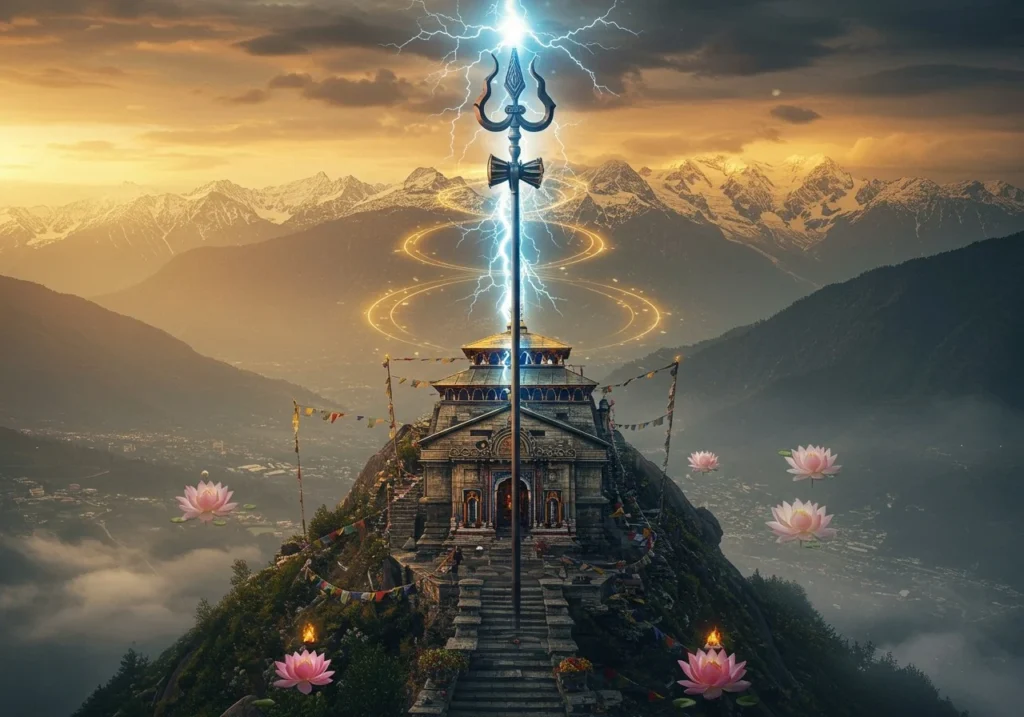Bijli Mahadev: The Sacred Lightning of Lord Shiva
High in the serene Himalayas, amidst the whispers of ancient deodar forests, lies a mystical temple dedicated to Lord Shiva—Bijli Mahadev. Unlike any other shrine, this temple holds a secret that defies time, where the very heavens pay homage to the deity through an astonishing celestial event. The temple’s legend is intertwined with lightning, devotion, and the eternal cycle of creation and destruction.
The Legend of Bijli Mahadev
Long ago, the divine land of Kullu was under the shadow of an enormous demon named Kulant. As per the Skanda Purana, Kulant was a mighty serpent-demon (Nāga) who sought to flood the valley by obstructing the flow of the sacred Beas River. The seers and inhabitants of the valley, fearing devastation, sought refuge in Lord Shiva.
Hearing their plea, Mahadev appeared in his formidable form and confronted Kulant. To vanquish the demon, Shiva struck him down with his trident (trishul), ending his reign of terror. However, before dying, Kulant warned that his body would still be a source of destruction. To prevent any such calamity, Shiva himself sat upon the demon’s remains, blessing the land and ensuring peace prevailed.
The Thunderous Ritual: When Heaven Touches Earth
To commemorate Shiva’s divine intervention and his sacrifice to protect the valley, the temple of Bijli Mahadev was established. The name “Bijli Mahadev” itself means “Shiva of Lightning”, and it carries a remarkable mystery.
It is said that every twelve years, a bolt of lightning strikes the Shiva Lingam inside the temple, shattering it into pieces. The locals believe this to be a sign of Shiva absorbing negative energies and renewing cosmic balance. After this divine event, the temple priests, in a sacred ritual, restore the broken Lingam using a mixture of butter and sattoo (barley flour), symbolizing Shiva’s eternal regeneration.
Scriptural References and Symbolism
The phenomenon of lightning striking the temple aligns with Hindu scriptures that describe Shiva as the master of destruction and rebirth:
- Rudra Samhita (Shiva Purana) mentions that Shiva, as Rudra, governs the forces of nature, including storms, thunder, and celestial fire. The lightning at Bijli Mahadev is believed to be a manifestation of Rudra’s cosmic energy.
-
Bhagavad Gita (Chapter 10, Verse 41) states:
“Yad yad vibhutimat sattvam shrimad urjitam eva va
Tat tad evaavagaccha tvam mama tejo-msha-sambhavam”(Whatever possesses glory, beauty, or power, understand that it has sprung from a spark of My splendor.)
The lightning at Bijli Mahadev can be seen as a direct manifestation of Shiva’s splendor and his power to destroy impurities.
- Skanda Purana describes how Lord Shiva often tests and blesses his devotees through natural elements. The ritual of the Lingam breaking and being restored echoes Shiva’s aspect of destruction (pralaya) followed by renewal (srishti).
The Pilgrimage and Devotion
The journey to Bijli Mahadev is an experience of devotion and endurance. Pilgrims trek through dense forests and steep paths to reach the temple, situated at an altitude of 2,460 meters. The breathtaking view from the temple overlooks the confluence of the Parvati and Beas rivers, symbolizing the cosmic union of Shiva and Shakti.
During Shivratri, thousands of devotees gather here to witness special prayers, believing that the divine lightning will once again descend, reaffirming Shiva’s presence.
The Eternal Protector of Kullu
Even today, the people of Kullu believe that Lord Shiva protects their valley by absorbing celestial energies through the Bijli (lightning). Scientists may explain this as natural electrostatic discharge due to the temple’s high altitude, but for devotees, it is nothing short of divine intervention.
Bijli Mahadev remains a powerful testament to faith, renewal, and cosmic balance, where the heavens themselves bow down to the destroyer and protector, Mahadev.
Would you dare to visit the temple when lightning is about to strike? Perhaps, in that very moment, you may feel the presence of Shiva himself.



